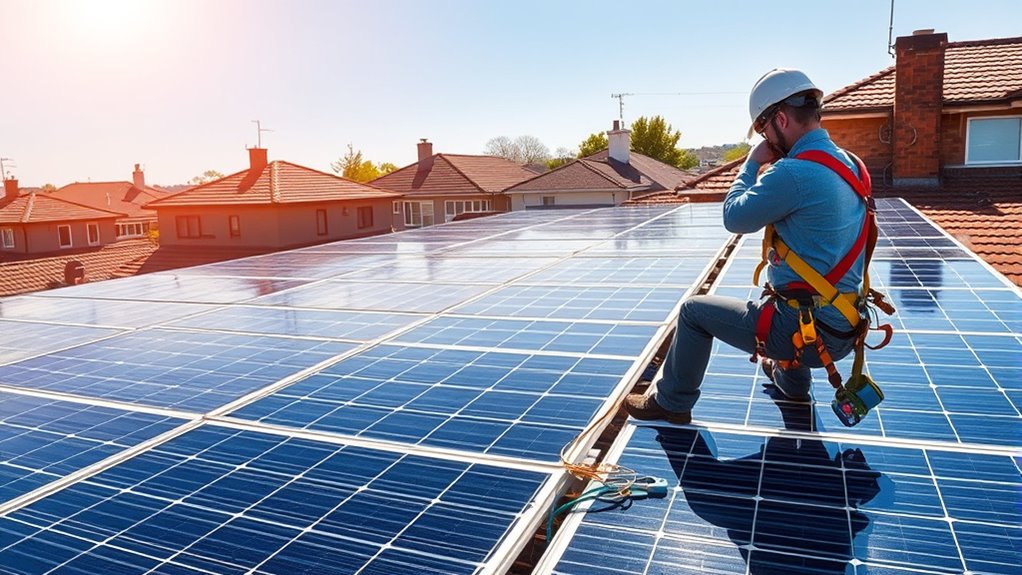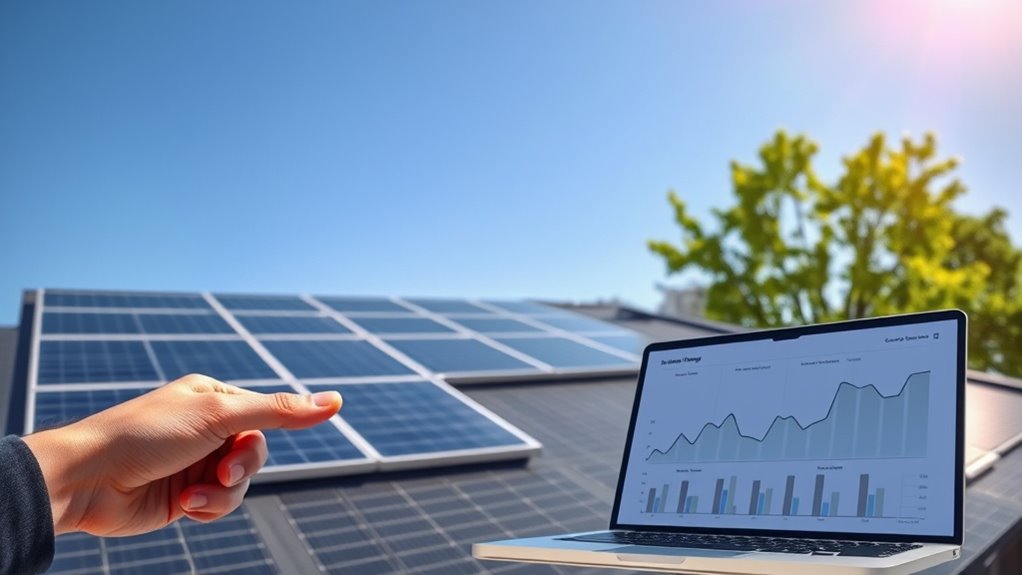Switching to solar power helps you save on energy bills, cut your carbon footprint, and boost your home’s value by harnessing renewable energy. You’ll need to assess your roof’s shading, orientation, and structural support before installation. Understand incentives like tax credits and net metering, explore financial options, and plan for maintenance to guarantee long-term savings. If you want an in-depth guide on making your solar journey successful, let’s explore more.
Key Takeaways
- Assess your home’s energy needs, roof condition, shading, and orientation to determine suitable solar system size and placement.
- Understand financial options like incentives, tax credits, leasing, and net metering to optimize costs and savings.
- Prepare for installation by securing permits, evaluating roof support, and scheduling regular maintenance and inspections.
- Choose high-quality solar panels and inverters, and monitor system performance to ensure long-term efficiency.
- Recognize environmental benefits, long-term savings, and how proper planning maximizes your solar investment.
Understanding Solar Power and Its Advantages

Solar power is a clean and renewable energy source that converts sunlight into electricity using photovoltaic cells. When sunlight hits these cells, it excites electrons, generating direct current (DC) power. An inverter then transforms this DC into usable alternating current (AC) for your home. Installing solar panels can substantially cut your electricity bills and reduce your carbon footprint. Because sunlight is abundant and free, solar energy offers long-term savings and sustainability. The system size depends on your home’s energy needs and roof space, making it customizable. Plus, various incentives and tax credits help lower initial costs. Solar power requires minimal maintenance once installed, providing a reliable, eco-friendly energy solution for years to come. Additionally, understanding solar panel efficiency can help optimize your system’s performance and energy output. Recognizing the importance of battery technologies can further enhance energy storage options, ensuring power availability even when sunlight is not present. Exploring system monitoring tools can help track your energy production and identify potential issues early. Being aware of system components can also assist in understanding how your entire setup functions seamlessly. Moreover, selecting the right installation location is crucial for maximizing sunlight exposure and overall system efficiency.
Preparing Your Home for Solar Installation

Before installing solar panels, you’ll want to assess your home’s energy efficiency and roof condition. Start by reviewing your energy bills to understand your typical usage and identify areas to improve efficiency, like sealing leaks or upgrading insulation. Inspect your roof for damage, signs of wear, or shading from trees and nearby structures, as these can impact system performance. Check the roof’s orientation and tilt; south-facing roofs generally maximize sunlight exposure. Ensure your roof can support the weight of solar panels, and consider any repairs needed beforehand. Additionally, gather information about local permits and regulations. Performing a roof integrity assessment helps identify potential issues early and ensures your home is ready for a smooth installation process and helps optimize your solar system’s efficiency and longevity. Conducting a home energy audit can also highlight additional improvements to maximize your solar investment. Being aware of solar panel weight requirements is crucial to prevent structural issues and ensure safety during installation. Furthermore, understanding the installment process can prepare you for the steps involved and any potential disruptions to your daily routine.
The Solar Installation Process Step-by-Step

Installing solar panels involves a series of well-coordinated steps that guarantee a safe and efficient setup. First, your installer marks the panel layout on your roof, considering sun exposure and shading. Next, they install mounting attachments, ensuring a secure foundation. Railing systems are secured, and solar panels are fastened onto the mounts. Wiring connections follow, linking panels to inverters that convert sunlight into usable electricity. Electrical wiring runs safely from the panels to your main breaker panel. Once everything is connected, an electrical inspection is performed to ensure safety and code compliance. Proper system sizing ensures your solar setup meets your energy needs efficiently. Additionally, proper system efficiency can influence the overall performance of your system, so it’s an important factor to consider during installation. As part of the process, your installer may also evaluate your energy consumption patterns to optimize system performance. After approval, the utility company grants interconnection, and your system is turned on. Throughout the process, your installer follows safety protocols, local codes, and best practices to complete the installation smoothly.
Financial Options, Incentives, and Cost Savings

To make solar energy more affordable, you can explore various financial options and incentives that lower upfront costs and accelerate your return on investment. Leasing or power purchase agreements (PPAs) allow you to install solar without high initial expenses, paying instead through monthly rates. The federal Investment Tax Credit (ITC) offers a significant tax credit, reducing your overall cost. Many states and local governments also provide rebates, grants, or property tax exemptions. Utility net metering credits you for excess energy sent back to the grid, further increasing savings. Additionally, understanding merchant services risks and compliance requirements can help you avoid potential pitfalls if you plan to finance your solar project through third-party providers. Being aware of system warranties and maintenance costs can also protect your investment over time. Incorporating installation costs into your financial planning ensures a more accurate estimate of total expenses. It’s also important to consider electric power generation options, such as integrating solar with other renewable sources, to maximize efficiency and savings. Exploring solar panel efficiency improvements can further enhance your system’s performance and financial benefits. By combining these incentives and financing options, you can shorten your payback period and maximize long-term savings while reducing your carbon footprint. Carefully compare your choices to find the best fit for your financial situation.
Maintaining Your Solar System for Long-Term Performance

Once your solar system is up and running, regular maintenance helps guarantee it continues to perform at its best over the years. Keep your panels clean by gently washing off dust, leaves, and dirt that can reduce efficiency. Check for shading issues caused by growing trees or new structures. Monitor your system’s performance using apps or hardware to spot drops in energy production early. Inspect wiring and connections for signs of corrosion or damage. If your inverter is over 10-15 years old, consider replacing it to maintain maximum output. Review warranty coverage periodically and keep records of maintenance, warranties, and inspections. Staying aware of outdoor conditions and potential obstructions can also help optimize your system’s performance. Additionally, understanding the AI integration in modern solar systems can provide insights into optimizing energy use and troubleshooting issues. Regularly evaluating energy efficiency and adopting new technologies can further enhance your system’s longevity and output. Embracing personal development techniques such as visualization and goal setting can further enhance your understanding of renewable energy benefits and motivate ongoing system upkeep. Incorporating remote work productivity strategies can help you stay organized and ensure timely maintenance, avoiding overlooked issues. These simple steps help ensure your solar system remains reliable, efficient, and cost-effective for the long haul.
Frequently Asked Questions
How Does Shading Affect Solar Panel Efficiency?
Shading substantially reduces your solar panel’s efficiency because it blocks sunlight, which is essential for generating power. Even a small shadow from trees, chimneys, or neighboring buildings can cause a big drop in energy output. To maximize your system’s performance, you should trim trees, avoid installing panels where shading occurs, and consider panel placement carefully. Regularly check for new shadows that could impact your panels over time.
What Are the Best Roof Orientations for Solar Panels?
You should install solar panels facing south for ideal sunlight exposure if you’re in the Northern Hemisphere, maximizing energy production throughout the day. East and west orientations are good options, especially if you want energy in the mornings or afternoons. Avoid shaded areas and aim for a roof that’s unobstructed. Properly orienting your panels guarantees you get the most out of your solar system, saving you more money and reducing your carbon footprint.
Can I Install Solar Panels on a Flat Roof?
Yes, you can install solar panels on a flat roof. You’ll typically use mounting brackets to tilt the panels at an ideal angle for sunlight exposure. This setup maximizes your system’s efficiency, even on a flat surface. Just guarantee your roof is structurally sound and plan for proper shading and orientation. Working with a qualified installer helps you choose the best mounting options and ensures a safe, effective installation.
What Is the Typical Lifespan of Solar Panels?
Think of solar panels as the marathon runners of your energy system—they’re built to last. Typically, they’ll serve you well for 25 to 30 years, gradually losing efficiency but still providing substantial savings. Regular maintenance, like cleaning or inverter replacement around year 10-15, keeps them running smoothly. With warranties often covering 25 years, you can confidently enjoy clean energy knowing your panels are a long-term investment.
How Do Weather Events Impact Solar System Performance?
Weather events can temporarily reduce your solar system’s performance. Heavy snow or hail may cover or damage panels, decreasing energy output. Strong winds or storms can loosen mounts or cause debris buildup. Heavy rain or fog might lower sunlight exposure, reducing efficiency. However, most systems are built to withstand weather, and regular inspections help make certain your panels stay in good shape. After severe weather, check your system and clean or repair as needed.
Conclusion
Now that you’re equipped with all the solar knowledge, you’re ready to make the switch and embrace a greener future. Remember, just like a well-tended garden flourishes over time, your solar system will reward your patience and care with long-lasting savings and sustainability. Don’t wait for a knight in shining armor—take charge today. With a little effort, you’ll harness the sun’s power and illuminate your home’s bright, eco-friendly path ahead.





